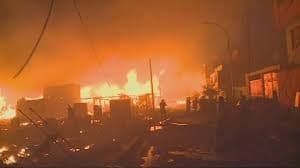Loading News Article...
We're loading the full news article for you. This includes the article content, images, author information, and related articles.
We're loading the full news article for you. This includes the article content, images, author information, and related articles.
A massive fire in Lima, Peru, has displaced hundreds and destroyed numerous homes, underscoring critical issues in urban planning, informal settlements, and the regulation of hazardous materials, a situation with parallels to Kenya's own disaster management challenges.

A significant fire on Saturday, October 11, 2025, ravaged the Pamplona Alta area in San Juan de Miraflores, a district in Lima, Peru, destroying at least 100 homes and leaving approximately 300 people displaced. The inferno, suspected to have originated from an illegal pyrotechnics warehouse, sent plumes of smoke and fireworks into the sky, captured vividly by drone footage. While no fatalities have been reported, four people sustained injuries.
Peruvian authorities, including President José Jerí, visited the affected area to coordinate humanitarian aid and assess the damage. Firefighters faced considerable challenges in controlling the blaze due to a lack of readily available water and the precarious construction of homes, often made from wood and other flammable materials.
The incident in Lima resonates with Kenya's ongoing struggle with frequent and often devastating fire outbreaks, particularly in informal settlements. Data from the Kenya Red Cross Society (KRCS) Emergency Operations Centre (EOC) indicates a steady rise in fire incidents over the past 14 years, ranking them second only to road traffic accidents in occurrence. Between 2020 and 2024, 1,606 fire incidents were reported across 17 counties in Kenya, affecting 28,000 households and resulting in 2,392 casualties and 293 fatalities.
Nairobi, Kiambu, Nakuru, Mombasa, Nyeri, and Bomet counties have experienced the most significant impacts from these fires. A substantial portion of these incidents, approximately 40% in Nairobi, occur in informal settlements, where houses are often constructed from highly flammable materials and access for emergency services is limited. Electrical faults and arson are frequently cited as causes, though many incidents lack documented origins.
Kenya has a National Policy for Disaster Management, first introduced in 2009, which aims to enhance preparedness, mitigation, and response to disasters. More recently, in June 2025, Kenya launched its National Disaster Risk Management (DRM) Strategy 2025–2030. This strategy seeks to shift from short-term emergency response to a more proactive approach, focusing on anticipatory action, integrated risk reduction, and sustainable development planning. It also calls for a comprehensive Disaster Risk Management Bill and further decentralisation of risk governance.
Despite these policies, the recurring nature of fire tragedies suggests gaps in implementation and enforcement, particularly concerning urban planning, building codes, and the regulation of hazardous materials in residential areas. The National Policy for Disaster Management in Kenya emphasizes the establishment and strengthening of disaster management institutions and mainstreaming disaster risk reduction in development processes.
Community members in Kenyan informal settlements often act as first responders to fires, frequently being the sole individuals to tackle initial outbreaks due to challenges in emergency service access. Fire brigades in Nairobi have reported responding to at least two fire incidents daily across the city. Experts, such as Shabaan Said, a Plastic Surgeon and Chairperson of the Burn Society of Kenya, have highlighted the paramount need for targeted campaigns in informal homes, where most incidents occur.
The Lima fire, much like similar incidents in Kenya, highlights the severe risks associated with unregulated industrial activities, particularly the storage of highly flammable materials, within densely populated residential areas. The rapid spread of fires in such settings is often exacerbated by the use of precarious building materials and inadequate infrastructure, including limited access to water for firefighting. These events lead to significant loss of property, displacement, and potential for injury or death, placing immense strain on emergency services and humanitarian organisations.
While an illegal pyrotechnics warehouse is suspected as the cause of the Lima fire, official investigations are ongoing to confirm the exact origin. The extent of regulatory oversight and enforcement in such areas remains a critical question, both in Lima and in Kenyan urban centres facing similar challenges. The effectiveness of existing disaster management policies in preventing such large-scale destruction is also a subject of ongoing debate among stakeholders.
The fire in San Juan de Miraflores, Lima, began on Saturday, October 11, 2025, at approximately 5:30 PM local time (1:30 AM Sunday, October 12, 2025, EAT). Firefighters brought the blaze under control after several hours. Peruvian authorities have initiated efforts to provide immediate relief and plan for the reconstruction of affected homes. The Ministry of Housing is expected to conduct a census of affected families to facilitate housing rental bonuses and reconstruction programmes.
In the coming weeks, attention will focus on the official determination of the fire's cause in Lima and the measures the Peruvian government will implement to prevent similar incidents. For Kenya, the effectiveness of the recently launched National Disaster Risk Management Strategy 2025–2030 in translating policy into tangible improvements in fire safety and urban resilience, particularly in informal settlements, will be a key area to watch. The enactment of a comprehensive Disaster Risk Management Bill and the decentralisation of risk governance are crucial steps in this regard.
Keep the conversation in one place—threads here stay linked to the story and in the forums.
Other hot threads
E-sports and Gaming Community in Kenya
Active 6 months ago
Popular Recreational Activities Across Counties
Active 6 months ago
The Role of Technology in Modern Agriculture (AgriTech)
Active 6 months ago
Investing in Youth Sports Development Programs
Active 6 months ago